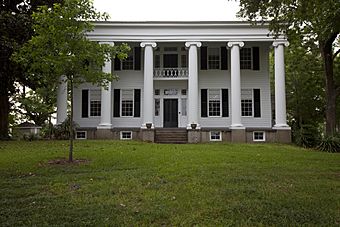Thornhill (Forkland, Alabama) facts for kids
Quick facts for kids |
|
|
Thornhill
|
|

The front elevation of the main house in 2010
|
|
| Nearest city | Forkland, Alabama |
|---|---|
| Built | 1833 |
| Architect | William Nichols |
| Architectural style | Greek Revival |
| NRHP reference No. | 84000618 |
| Added to NRHP | May 10, 1984 |
Thornhill is a very old and important house near Forkland, Alabama. It's a type of large farm called a plantation. The main house was built in 1833. It has a special style called Greek Revival, which looks like ancient Greek buildings. James Innes Thornton built this beautiful home. On May 10, 1984, Thornhill was added to the National Register of Historic Places. This means it's a special place worth protecting because of its history.
History of Thornhill
James Innes Thornton was born in Virginia in 1800. He went to college and then moved to Huntsville, Alabama, to become a lawyer. In 1824, he was chosen to be Alabama's third Secretary of State. This job is like a chief clerk for the state government. He held this important position until 1834.
After his time in public service, Thornton became a farmer in Greene County. He married Mary Amelia Glover in 1825. They had two children. Mary's brother, Williamson Allen Glover, owned the nearby Rosemount plantation. Mary passed away after a few years.
In 1831, Thornton married Anne Amelia Smith. Anne died in 1864. He married a third time in 1870 to Mrs. Sarah Williams Gould Gowdy. James Innes Thornton passed away at Thornhill in 1877.
James Innes Thornton's family had a connection to George Washington. George Washington's aunt, Mildred Washington Gregory, had daughters who married three Thornton brothers. One of these daughters, Frances, was George Washington's cousin. She married Col. Francis Thornton III, who was James Innes Thornton's great-grandfather.
Thornhill was developed as a cotton plantation in the early 1830s. It covered a very large area, about 2,600 acres (10.5 square kilometers). After the American Civil War ended in 1865, James Innes Thornton shared his thoughts. He believed that fighting for secession (states leaving the United States) was wrong, even though people fought bravely.
Architecture of the Main House
It is believed that William Nichols designed the main house at Thornhill. James Innes Thornton hired him in 1832. Nichols was a famous architect. He was the state architect of Alabama starting in 1827. He designed the first buildings for the University of Alabama and the old Alabama State Capitol building. He also designed the former Mississippi State Capitol building.
The main house at Thornhill was finished by 1833. Around 1850, a large, two-story front porch, called a portico, was added. This portico has six tall Ionic columns, which are a classic Greek style. A builder named David Rinehart Anthony is thought to have added this porch and the second-story balcony.
The house is about 55 feet (16.8 meters) wide. Inside, there is a long central hallway, 14 feet (4.3 meters) wide and 40 feet (12.2 meters) long. At the back of the hall, there is a beautiful spiral staircase. There are two rooms on each side of the hall. The front room on the left was the parlor, and behind it was the dining room. On the front right was the main bedroom, with the plantation office behind it.
Upstairs, there is a similar hallway and four more bedrooms. All eight rooms are about 19.5 feet (5.9 meters) square. The ceilings downstairs are 12 feet (3.7 meters) high, and upstairs they are 11 feet (3.4 meters) high.
Originally, there was a brick kitchen behind the house, but it later burned down. Some parts were added to the house between 1890 and 1949. These additions were removed in 1994 and rebuilt to look more like the original design. The house and its land were carefully recorded in 1934 by the Historic American Buildings Survey.
The plantation schoolhouse was built around 1845. The Thornton children and children from nearby farms were taught there. Around the schoolhouse are very old post oak trees, about 230 years old.
Family Cemetery
A family cemetery is located a short distance east of the main house. Many members of the Thornton family are buried there, including:
- James Innes Thornton (1800 - 1877)
- Anne Amelia Smith Thornton (1812 - 1864), his second wife.
- James Innes Thornton Jr. (1835 - 1837), his son.
- Fitzgerald Thornton (1837 - 1939), his son.
- Catherine (Kate) Marshall Thornton (1842 - 1870), his daughter.
- Harry Innes Thornton (1848 - 1900), his son.
- Sallie A. Blocker Thornton (1849 - 1924), his daughter-in-law.
- Bettie Cooper Thornton (1876 - 1878), his granddaughter.
- Harry Innes Thornton (1883 - 1938), his grandson.
- George Francis Thornton (1885 - 1889), his grandson.
Some other family members are buried in different cemeteries. James Innes Thornton's first wife, Mary Amelia Glover Thornton, is buried in the Glover Mausoleum in Demopolis. His third wife, Sarah Williams Gould Gowdy Thornton, is buried in Boligee.






